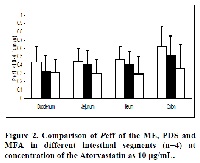Design and development of microemulsion drug delivery system of atorvastatin and study its intestinal permeability in rats
Keywords:
Microemulsion, Zeta potential, Atorvastatin, Single-pass intestinal perfusion (SPIP) method, Compartment absorption and transit model (CAT)Abstract
The objective of this study was to design and develop microemulsion drug delivery system of Atorvastatin and to investigate its intestinal transport behavior using the single-pass intestinal perfusion method in rat. Microemulsion drug delivery system of Atorvastatin was prepared by water titration method and optimized formulation was characterized. The permeability behavior of Atorvastatin over three different concentrations (10, 20 and 40 μg/mL) was studied in each isolated region of intestine (i.e. duodenum, jejunum, ileum and colon) of rat by single-pass intestinal perfusion method in rat method at a flow rate of 0.2 ml/min. The concentration of the sample was determined by HPLC and the effective permeability coefficients were calculated. Considering the high correlation of rat permeability coefficient values with those of human, the human intestinal permeability was predicted using the Lawrence compartment absorption and transit model. The intestinal permeability of Atorvastatin in microemulsion, plain drug suspension and marketed formulation was also compared. The particle size and zeta potential of Atorvastatin microemulsion were (18.2±0.3) nm and (–9.19±0.8) mV respectively. There was no significant difference in permeability coefficient in jejunum, duodenum and ileum with same concentration but higher in colon was observed. The permeability coefficient in jejunum at 10 μg/mL was significantly higher than that at 40 μg/mL (p< 0.01). The estimated human intestinal permeability of Atorvastatin for the microemulsion was relatively higher. Based on the above results, it could be concluded that microemulsion formulation could enhance the intestinal permeability of Atorvastatin and thus could be presented as a possible alternative to traditional oral formulations for improving the oral absorption of Atorvastatin.
References
Shah NH, Carvajal MT, Patel CI, Infeld MH,
Malick AW. Self-emulsifying drug delivery
systems (SEDDS) with polyglycolyzed glycerides
for improving in vitro dissolution and oral
absorption of lipophilic drugs. Int J Pharm
;106:15–23.
Wu W, Wang Y, Que L. Enhanced bioavailability
of silymarin by selfmicroemulsifying drug
delivery system. Eur J Pharm Biopharm
;63:288–294.
Kommuru TR, Gurley B, Khan MA, Reddy IK.
Self-emulsifying drug delivery systems (SEDDS)
of coenzyme Q10: formulation development and
bioavailability assessment. Int. J Pharm
;21(2):233–246.
Itoh K, Matsui S, Tozuka Y, Oguchi T,
Yamamoto K. Improvement of physicochemical
properties of N-4472 Part II: characterization of
N-4472 microemulsion and the enhanced oral
absorption. Int J Pharm 2002;246:75–83.
Kang BK, Lee JS, Chon SK, Jeong SY, Yuk SH,
Khang G, Lee HB, Cho SH. Development of
Microemulsion drug delivery system for oral
bioavailability enhancement of simvastatin in
beagle dogs. Int J Pharm 2004;274:65–73.
Charman WN, Stella VJ. Transport of lipophilic
molecules by the intestinal lymphatic system.
Adv Drug Del Rev 1991;7:1-14.
www.rxlist.com/Atorvastatin monograph.
Laurent S, Kelly C, Lin P, Ken T, Lori T.
Evaluation of a single-pass intestinal- perfusion
method in rat for the prediction of absorption in
man. J Pharm Pharmacol 2001;53:1007-1013.
Patel D, Sawant KK. Oral bioavailability
enhancement of acyclovir by self
microemulsifying drug delivery systems. Drug
development and industrial pharmacy
;33:1318-1326.
Abbofazeli R, Lawrence MJ. Investigation into
the formation and characterization of
phospholipids microemulsion.II: Pseudoternary
phase diagram of system containing waterlecithin-isopropyl myristate and alcohol:
Influence of purity of lecithin. Int. J. Pham
;106:51-61.
Achrya A, Sanyal SK, Moulik SP. Formation and
characterization of pharmaceutically useful
microemulsion derived from Isopropyl myristate,
Brij 30, Isopropyl alcohol and water. Current
Science 2001; 81(4):362-370.
Thomas JC, Smriti SS. Intestinal permeability of
chlorpyrifos using the single-pass intestinal
perfusion method in the rat. Toxicology
;184:125-133.
Zakeri MP, Valizadeh H, Tajerzadeh H, Azarmi
Y, Islambolchilar Ziba, Barzegar S, BarzegarJalali M. Predicting human intestinal permeability
using single-pass intestinal perfusion in rat. J
Pham Pharmaceut Sci 2007;10:368-379.
You J, Li QP, Yu YW, Cui FD. Absorption of
zedoary oil in rat intestine using in situ single
pass perfusion model. Acta Pharm Sin
;39:849-853.
Mario G, Giancarlo C. Theoretical considerations
on the in vivo intestinal permeability
determination by means of the single pass and
recirculating techniques. Int J Pharm
;229:95-105.
Zarghi A, Shafaati A, Foroutan SM, Khoddam A.
Determination of atorvastatin in human serum by
reversed-phase high-performance liquid
chromatography with UV detection. J
Chromatogr B Analyt Technol Biomed Life Sci
;8(6):41-45.
Sutton SC, Rinaldi MT, Vukovinsky KE.
Comparison of the gravimetric, phenol red and
C-PEG-3350 methods to determine water
absorption in the rat single-pass intestinal
perfusion model. AAPS Pharm Sci 2001;3(3): 25-
Urban F, Monica J, Hans L. Comparison between
permeability coefficients in rat and human
jejunum. Pharm Res 1996;13:1336-1342.
Desesso JM, Jacobson CF. Anatomical and
physiological parameters affecting
gastrointestinal absorption in humans and rats.
Food Chem Toxicol 2001;39:209-228.
Amidon GL, kou J, Elliott RL, Lightfoot EN.
Analysis of models for determining intestinal
wall permeabilities. J Pharm Sci, 1980;69:1369-
Fojo AT, Ueba K, Slamon DJ, Poplack DG,
Gottesman MM, Pastan I. Expression of
multidrug-resistance gene in human tumors and
tissues. Proc Natl Acd Sci USA 1987; 84:265-
Fagerholm U, Nilsson D, Knutson L, Lennernas
H. Jejunal permeability in humans in vivo and rat
in situ: investigation of molecular size selectivity
and solvent drag. Acta Physiol Scand 1999;165:1-
Ikegawa T, Ushigome F, Koyabu N, Morimoto S,
Shoyama Y, Naito M, Tsuruo T, Ohtani H,
Sawada Y. Inhibition of P-glycoprotein by orange
juice components, polymethoxy- flavones in
adriamycin-resistant human myelogenous
leukemia (K562/ADM) cells. Cancer Lett
;60:21-28.
Thomas YM, Daniel H, Richard AE, Hao T, Hien
N, Pavel K. Mechanism of colonic permeation of
inulin: is rat colon more permeable than small
intestine. Gastroemterology 1995;108:12-20.
Lawrence XY, Gordon LA. A compartmental
absorption and transit model for estimating oral
drug absorption. Int J Pharm 1999;186:119-125.
Sha XY, Yan GJ, Wu YJ, Li JC, Fang XL. Effect
of Microemulsion drug delivery system
containing Labrasol on tight junctions in Caco-2
cells. Euro J Pharma Sci 2005; 24:477–486.






